3. Wentworth's After the Hunt
A review of a used out-of-production 250 piece Wentworth puzzle, and discussion about buying used puzzles as a frugal alternative to buying new ones (about 3400 words; 16 pictures)
laser-cut Wentworth cutting designer – unknown
artist - Heywood Hardy (1842-1933)
about 250 pieces 10”x14” (25x36 mm) 3.5mm mdf (medium density fibreboard)

How I discovered wooden puzzles, and my search for inexpensive ones
I first discovered wooden jigsaw puzzles from seeing a Unidragon advertisement while waiting for a YouTube video to start. I admit it: It was the whimsies (AKA figural pieces, or rarely, silhouettes) that first caught my attention. I could see that these were not like the cardboard puzzles I had assembled many years ago. That was shortly before Christmas and I ordered one as a gift for my long-time friends Greg and Beth Skala, who have known since I first moved to Canada about fifty years ago. I knew that they liked assembling jigsaw puzzles.
Even before hearing how they felt about that wooden puzzle I became intrigued myself and began doing more online research about them. As I did so I found myself getting more and more convinced that this could be a fun hobby for me too. After Christmas, as soon as I heard how much they enjoyed it I ordered one for myself from Amazon Canada. By the time my puzzle arrived from Ontario only a few days later I had my table already cleared and ready to go. Even before completing it I was hooked!

My online research had yield other sources of wood puzzles, and with artwork that is more to my tastes. The next ones I ordered were three puzzles from Wentworth Wooden Puzzles, made in England. While awaiting their arrival I discovered that laser-cut wooden puzzles are also made here in Canada too, and one of those companies is right here in Victoria!
Shipping from Great Britain is rather slow, so by the time my Wentworths arrived I had already assembled two puzzles from Puzzle Lab and one from Stumpcraft. I had also come to realize that I was beginning to find jigsaw puzzles rather addictive. I could see that, even though I was carefully choosing puzzles with images that I thought I would enjoy doing over and over again, this new hobby could prove quite expensive.
My first plan was that I would alternate assembling wood puzzles with cardboard ones. So I went to Boland Books, a local store that I knew has a large selection of puzzles. I bought an attractive and challenging one from Cobble Hill Puzzles after I overheard two other customers say that they had enjoyed it. Both its 1000 piece size and its design did indeed make it satisfying to assemble but I did miss the luxurious tactile feel that I was getting used to from wooden ones. I suspect I will still do cardboard puzzles occasionally but I knew I wouldn’t enjoy alternating them with wood.
I bought one inexpensive wooden one from China, and will discuss that frugal option in future newsletters/blogs, but so far my most satisfactory inexpensive wood puzzles have come from buying vintage ones. That is certainly not to say that vintage wood hand-cut jigsaw puzzles are always less expensive than new ones. Like other items in the antiques and collectables marketplace, collectors pay very high prices for puzzles by highly-regarded cutters and some historic companies. At auction, some vintage hand-cuts sell for as much or more than the price of brand new puzzles from the best and most expensive current laser cutting companies.
I am beginning to recognize what characteristics attract collectors’ attention, and which ones have limited appeal to them. Collectors definitely prefer rare early puzzles, certain premium-quality series that were made in jigsaw puzzle factories of the early 20th century, but especially, puzzles that were designed and made by renowned hand cutters. However many vintage hand-cut puzzles, especially those with out-of-fashion artwork, do sell for reasonable prices. I regularly bid for them on eBay, and sometimes I am the winning bidder.
As far as I can tell, people have not yet begun collecting puzzles that are made using laser-cutting technology (except for a few special “limited edition” releases.) That is where Wentworth Wooden Puzzles comes into the picture. Wentworth did not invent laser cutting but it was one of the first companies to apply that new new technology to puzzle making. Since the company was founded in 1996 it has developed a solid reputation for reliably producing enjoyable but relatively inexpensive wood puzzles. Since even the oldest Wentworth puzzles are less than 30 years old I hesitate to call them “vintage” even when specific ones are now out-of-production. [Update: since writing this I have come to think of the early Wentworths from about 2010 or earlier to be a type of vintage puzzle. That is because techniques have developed since that time to take better advantage of the new technology, and also because I have come to prefer the cutting designs of Wentworth puzzles from that era to be superior to their current products.]
This deep-dive puzzle review will compare and contrast this older “green box” Wentworth puzzle (production date unknown but perhaps made in the first decade of the 21st century) to both contemporary Wentworth puzzles that I bought from the company and to standard-quality vintage factory-made puzzles that I bought for approximately similar prices at auction. But first, here is some information about the image on this puzzle.
The artwork
The artwork for After the Hunt is a painting by the Heywood Hardy (1842-1933.) Hardy grew up in Bath, England, the youngest child in a very artistic family. His father, two of his brothers, and many of his cousins were also professional painters. He left the family home at the age of 17 and began working independently as a painter in a nearby town, specializing in depicting animals.
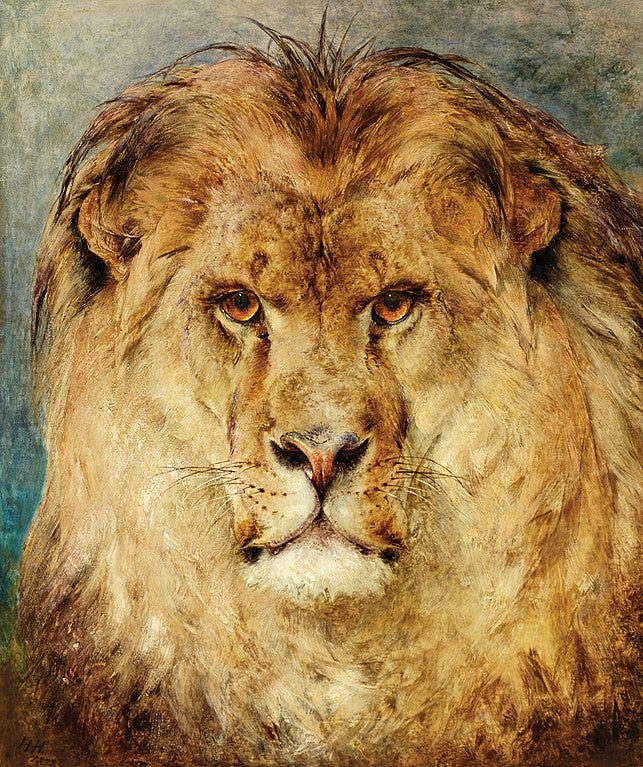
Hardy was modestly successful even at that early stage of his career and earned enough money that, with some financial support from his brothers, he was able to move to Paris in 1864 and spend the next five years there living the bohemian artist lifestyle. In Paris he copied paintings at the Louvre and studied at the École des Beaux-Arts (from Isidore Pils, an academic painter who specialized in religious and military subjects.) We now remember that era of artists in Paris for the rise of impressionism. I could find no indication that Hardy ever hung around with that crowd, but some art historians have noted impressionist influences in his paintings that contrast with the artistic style of his English contemporaries.
When Hardy returned to England in 1969 he settled near London and returned to his lifelong focus on painting animals, as well (as a phrase that I frequently found in descriptions of his work) “genre paintings”. I had to look that up. Genre painting is the depiction of everyday life, portraying common people doing common things. The images can be realistic, but they are frequently sentimental or romanticized by the artist to portray an idealized depiction of their subjects and time period.

Such paintings have proven to be the backbone of many painters’ careers because they are reliably marketable to bourgeoisie or middle-class patrons. It certainly worked well for Heywood Hardy. He became prosperous and well-regarded in the English artistic community, specializing in sensitive animal portraits (such as those of favourite pets, award-winning livestock, and especially portraits of famous race horses.) But he is most famous for his many, many paintings like the one in this puzzle of people, horses, and dogs before, during and after fox hunting (but never showing the violent finale of the chase.)
The cutting designer
The Wentworth company has never identified its cutting designers by name. Good cutting design is a major factor – at least as important as the image – in the creation of an enjoyable puzzle. Whenever possible I want to give credit-where-credit-is-due to the puzzle designers in my puzzle review essays.
Wentworth was first founded in 1994, but like the many laser-cutting companies that have sprung up during the Covid pandemic the company began as a small husband and wife workshop operation. Kevin Preston decided to use the then-novel laser-cutting technology for the new enterprise, and he personally spent about two years figuring out how to do it, but his actual background was as an accountant. I suspect that he was the company’s original cutting designer but as the company grew and other business roles absorbed his time I suspect that he hired or contracted for someone to do the cutting design role.
Basically, designing for laser cutting is similar to designing for hand-cutting, except that cutting patterns can include fine details and intricacies that would be very difficult or impossible to cut by hand. In hand cutting the details of a cutting design are a product of both muscle memory and on-the-fly improvisation. However, in designing for laser cutting there is more opportunity for creative planning and making improvements made based on feedback from cutting prototypes. Once a pattern is finalized there is no limit to the number of exact copies that can be made so that design time can be amortized over the hundreds of identical puzzles.
Wentworth is now a very large company, probably with various cutting designers either on the payroll or working under contract. However unlike some of the large jigsaw puzzle companies like Liberty or Artifact in the US, Wentworth does not provide any information about the identity of who deserves the credit for this important and creative aspect of their products.
I don’t have any information available to me about how and when Wentworth grew and expanded. Also, since Wentworth doesn’t provide dates for when individual puzzles go in and come out of production I cannot say whether this particular puzzle was introduced when Kevin Prescott was still doing the cutting design or whether it was done by a later anonymous designer. But since the whimsies in this puzzle are quite basic I suspect that this puzzle MIGHT have been designed by Kenneth Preston.
[Update: British jigsaw puzzle librarian David Shearer, who operates The Jigasaurus website, estimates that his copy of this puzzle was made in 2015. If that is the case it is unlikely that Kenneth Preston was the designer.]
The development of laser cutting technology, and the birth of Wentworth as a company, are both interesting stories in their own right. I’ll save those tales for another time.
First impressions and comparisons
Contemporary Wentworth puzzles are packaged in a purple bag within an attractive square cardboard box with a burgundy coloured bottom and a beige-grey lid. This older puzzle comes in a green bag within a narrower box with a pale yellow bottom and a dark green lid. I understand that the company’s very first bags were yellow, then came these green ones, then some short-lived brown ones, and finally the current burgundy bags. Thus, the colour of the bags gives a very rough indication of a puzzle’s age but I don’t know the dates when the various packaging changes were made.
The first things I noticed immediately after opening the bag and dumping out the pieces is that the image is very shiny and the pieces are slightly thicker and lighter (in both weight and colour) than the 3mm medium-density fibreboard (mdf, in Britain called medite) that the company now uses. But they aren’t plywood, which I understand is what Wentworth’s earliest puzzles were made from. They do seem to be a bit softer than the pieces in their new puzzles but that might just be my impression; I don’t have a tool to measure their hardness.

After the Hunt was printed on shiny-stock paper which was then affixed to the mdf. The printing itself is very high quality and as you can see the colours are deep and rich. Quality of printing is one of the most obvious improvements I see from vintage jigsaw puzzles to newer ones. The printing for this puzzle is nearly equivalent to a puzzle I recently assembled for which a new high-end UV printer was used to print on glossy paper.
Recent Wentworth puzzles are printed directly onto the fibreboard. I have become quite a fan of this approach because in some cases it gives a 3D effect that makes it look like the image has been painted rather than printed (especially when the image is of a painting that has loose brush-strokes.) I don’t know if such an effect would have showed with this image, and for this image the glossy paper works quite well. Downsides of glossy paper are that assembly under poor artificial lighting like I have, or while trying to take photos of the puzzle, the reflections can cause problems.
I have assembled three contemporary Wentworth puzzles. This puzzle had about the same number of whimsies as them, although the ones on the new puzzles are more delicately outlined and include small interior laser-cuts to show details and make them more image-like than just silhouettes. These whimsies are quite rudimentary, similar to those in a vintage factory-made hand-cut puzzle. I was surprised that there are three two-piece whimsies. I can’t recall seeing multi-piece ones before in my Wentworths or in a vintage factory-made hand-cut puzzle.
Assembly
As usual, I tried to do this puzzle without benefit of the picture on the cover. I had bought it from an eBay auction, received it about six weeks ago, and had not looked at the picture since. About all that I remembered about the image when starting it was that it had fox hunters on their horses in the vicinity of townspeople surrounded by buildings, and that it was in landscape orientation.

This assembly went quite quickly (by my standards.) In fact, it felt like the easiest puzzle that I have assembled to date. I attribute that primarily to the fact that it is only 250 pieces and the image separates the colours into readily-identifiable areas, however also my puzzling skills are probably improving. The cutting pattern is fairly straightforward by wood puzzle standards. It did not include any colour-line cutting, but there were a few disguised edge pieces and two of the corner pieces were disguised. All in all, it was a fun build rather than a challenging one.
Conclusions and what I learned
This used puzzle in like-new condition cost me £13.50 ($17 US). Admittedly this was a very good price, I think because fox-hunting images are very out of fashion these days (see here for a discussion about that.) More typically, relatively new 250 piece Wentworth puzzles in good condition sell for £20 (USD $25) and brand new 250 piece Wentworths are currently listed at £32 ($40), although the company often has sales of selected puzzles at 15% off. Thus, this particular puzzle cost me less than half the price of a new Wentworth Wooden Puzzle, even ones on sale.
[Digression: Most of the Wentworth puzzles that come up on eBay are being sold by people in Great Britain. When buying be very aware of the cost of shipping; it is sometimes more than the price of the puzzle itself, especially if the seller lists it with eBay’s default “Expedited Global Priority Shipping” option, but it becomes less of a factor if they seller is willing to combine multiple puzzles into one shipment.
GPS is eBay’s collaboration with the Pitney-Bowes shipping company. That method is very easy for the seller and provides for fast delivery, but is also very expensive – often costing more than the puzzle itself. (Among its costly features is that the system pre-pays customs duties for everything shipped even though there is no duty owed for puzzles sent to Canada or the US.) When a puzzle is offered that appeals to me but that is the designated shipping method I always contact the seller and ask if they are willing to ship by standard Royal Mail. I also check to see if the seller has other puzzles on offer, or to be offered soon, and is willing to combine any purchases I make into one shipment to save costs.
Another caution when buying used puzzles is that you want an assurance that it has all of its pieces and is in good condition. If the seller is a puzzle-person the posting will usually include a photo of the completed puzzle, and a reputable seller will acknowledge any damage rather than take a buyer-beware attitude (although it is also good idea to zoom in and examine the completed puzzle for yourself.) Once I have had a satisfactory transaction (good communication; puzzle is as described/depicted; safely packaged; Royal Mail; combined shipping) with a particular seller who posts multiple puzzles I keep that person on my “saved sellers” list.
Not everyone who sells vintage or used puzzles online is a puzzle person. Sometimes they are bargain hunters who don’t do puzzles but bought one cheaply and then did some online research and found that wood puzzles sometimes sell for a lot of money. So far I have never bought a puzzle from someone who has posted one as “Buy it Now,” but I have had a few laughs seeing the prices they sometimes ask for what even I with my limited experience know is a low-grade Depression-era puzzle. End of digression]
My impression is that the cutting design of this puzzle is roughly similar to Wentworth’s usual new puzzles in its complexity and trickiness, but the pieces do seem to have a looser fit than their new puzzles I have assembled. This might be related to something else that I noticed about the cutting of this one.
The sides of the pieces are dark, which is typical of laser cutting, but some of them have a serrated edge. I’ve seen serration on the edges of a few hand-cut puzzles, but never on a laser-cut one. Perhaps it is due to Waddington’s early laser-cutting equipment. This slightly looser fit of the pieces did not bother me but it might detract from enjoyment of the puzzle for some people.
In my limited experience, the most important difference between new and older puzzles, however they are cut, is in the quality of the printing. Printing technology has greatly improved in recent years, and very high quality printing can now be done even using relatively inexpensive printers. Many older puzzles look pale compared to the bright vibrant colours that we can now expect from current puzzle makers. Also, older puzzles sometimes have paper that is loosened from part of a piece and needs to be glued back on, or has been torn off and is now missing. Even small current jigsaw puzzle workshops can now achieve high-quality printing, and can reliably adhere paper to the base with inexpensive equipment, so peeling should never be a problem with new puzzles, and pale-looking images should only be a purposeful feature of the artwork.
None of that is a problem with this particular Wentworth puzzle. As you can see the colours are full and rich, and there is no sign of peeling. But the new Wentworths that I have done are UV printed directly onto the fibreboard and have a matte finish, which I slightly prefer over this printed-on-glossy-paper technology.
Judging by this example, Wentworth’s cutting patterns have been of consistently high quality since the company’s early years, incorporating the inclusion of whimsies and some cutting diversions that were only available from the highest-quality series that came from the factory hand-cutting companies during that technology’s heyday.
On balance, and to the extent that I can generalize from this single experience to date with an older Wentworth, I would say that the overall quality of their older puzzles is almost as good as their current production.
Used Wentworth puzzles seem to sell for a price that is mainly related to their size and condition. Ones in very good or like-new condition seem to sell from about ½ the price of a new Wentworth from the factory on up to nearly their current full price.
The biggest drawback of buying a used puzzle from a reliable seller seems to be that, unlike buying from Wentworth’s huge catalogue of currently-available puzzles, at any given time there is a rather small selection of used puzzles available. However, over time, a large number of used Wentworths (especially the 250 piece size) show up in eBay auctions representing a wide variety of styles of artwork and they sometimes sell for a considerable discount from the price of a new Wentworth puzzle.
Comparing this puzzle to inexpensive factory-made hand-cut puzzles is more complicated. To date, the only ones that I have seen available this price range have either been damaged and/or had missing pieces, or have been from the cheaper lines in their companies’ products. These cheaper lines sometimes have some rather crude whimsies but mostly are cut in the kind of grid pattern that we tend to associate with cardboard puzzles. For a detailed review of an example of such a puzzle see my review of this one by Optimago. Both that one and this one had enjoyable images, but from a puzzle assembly point of view this was more challenging and fun.
Wentworth grew fairly quickly so even most of their out-of-production puzzles are considered too plentiful to be of much interest to collectors. Besides the fact that Wentworth’s wooden puzzles are relatively inexpensive to begin with, their lack of attention from collectors might be the main reason why used ones sell fairly cheaply as wooden puzzles go even when they are out of production. I think that they represent a good, frugal option for wood puzzle enthusiasts who are looking towards enjoyment of assembly rather than investment value.




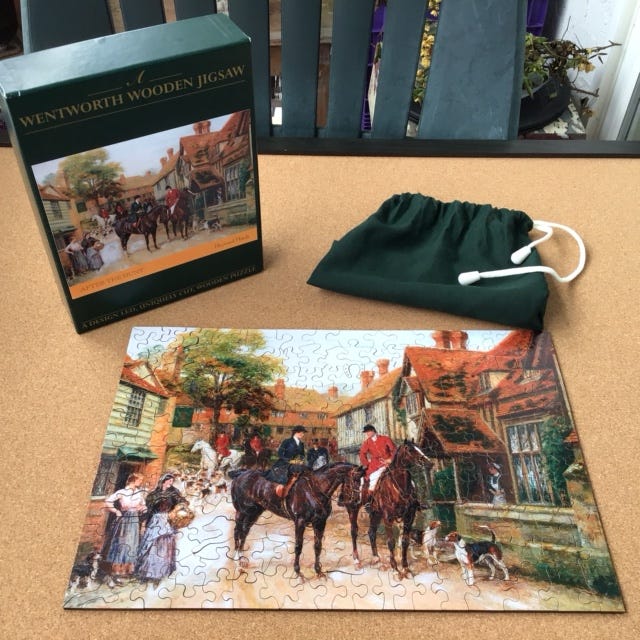
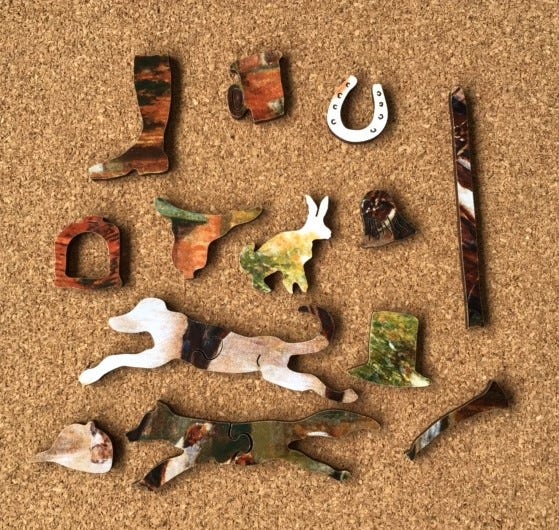


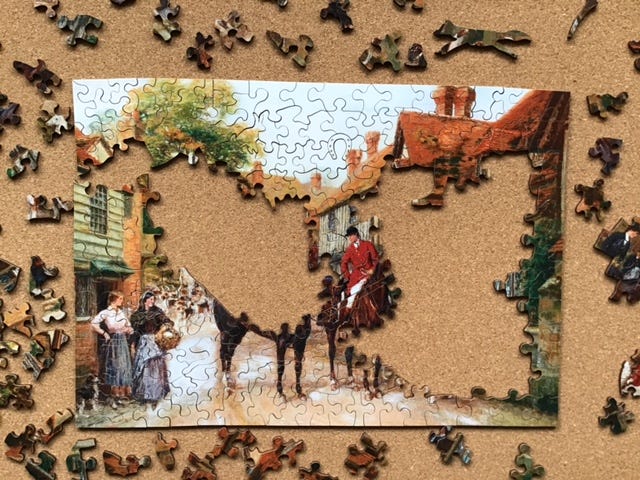


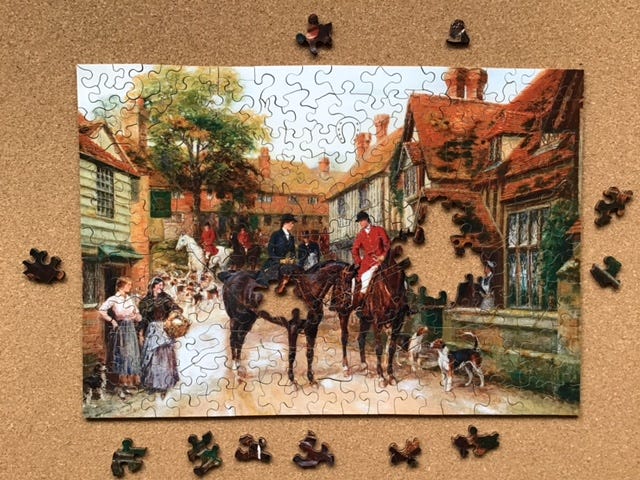
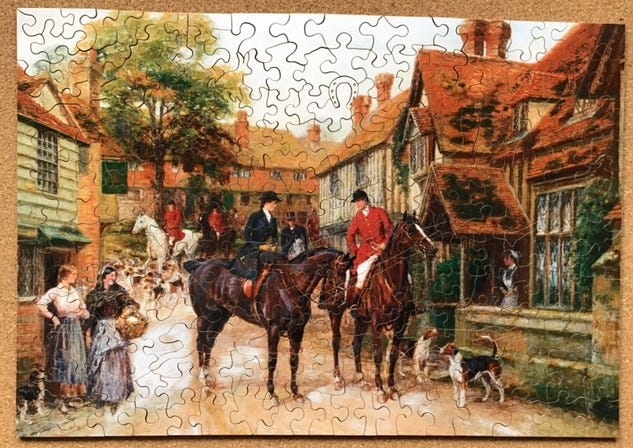

I enjoyed learning about an artist whose name sounded familiar, but about whom I knew essentially nothing. I also got a kick out of the fact that you were able to get a real bargain buying the after-the-hunt puzzle in like-new condition. Thanks for your essay.